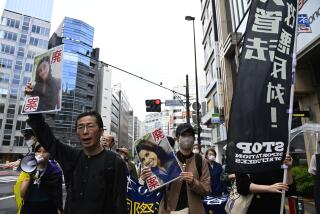Japan’s Sense of Racial Uniqueness Challenged
- Share via
TOKYO — The invaders came from across the sea.
With their advanced technology and overwhelming numbers, they quickly seized a foothold in the new world. The original inhabitants--tribes of hunter-gatherers--perished or were driven back.
The story may sound familiar, but this is not the European conquest of the Americas. It is what archeologists suggest may have happened in prehistoric Japan.
It is a controversial view of Japan’s past that should raise eyebrows in this country of history buffs. But it doesn’t. Most Japanese have never even heard of it.
That’s because although Japanese archeologists have come to accept the view that their ancestors migrated from mainland Asia, most popular discussion still adheres to the pre-World War II ideology that the Japanese are racially distinct from the rest of Asia.
“There has been a gap in thinking,” said Hisao Baba, curator of anthropology at the National Science Museum in Tokyo. “Archeology has made a lot of progress, but politics has made it difficult for the general public to take a critical look at their own past.”
Issues at the Core of Japanese Identity
Of course, Japan isn’t alone in mixing history with politics. British archeologists argue over the extent of Celtic vs. Anglo-Saxon heritage, and Americans have only recently begun to view their past from the perspective of American Indians.
But in few countries are the issues as charged as here.
The question of origin cuts to the core of Japan’s identity. Japanese have long celebrated themselves as ethnically unique, partly to offset the humiliation of having to borrow from the modern West. A sense of difference also made it easier to justify their country’s military occupation of neighbors like Korea and China earlier in the century.
Archeology in Japan long followed that line.
For much of this century, Japanese archeologists said Japan’s gene pool had remained isolated since the Ice Age, more than 20,000 years ago.
Confronted with evidence that a sudden change had swept Japan about 400 BC--replacing a millenniums-old hunter-gatherer culture with a society that could grow rice and forge iron weapons and tools--archeologists attributed it to nothing more than technological borrowing from the mainland.
But more recent analysis of skull shapes has shown the rice farmers who appeared 2,400 years ago were racially quite different from the hunters whom they replaced.
In the 1980s, new research on DNA taken from burial remains revealed even more startling results: The islands’ first inhabitants had little in common with most modern Japanese--but were almost identical to the Ainu, a tiny indigenous group found on the northernmost island of Hokkaido.
The same analysis also showed modern Japanese are close genetic kin to Koreans and Chinese.
A younger generation of Japanese archeologists now accepts that some sort of migration took place and that ethnic minorities like the Ainu are much more closely related to Japan’s original inhabitants.
Debate among researchers now focuses on just how many migrants came and whether they violently displaced the natives--or peacefully intermarried with them.
“It’s only since the 1970s that we started to see this period in history more dispassionately,” said Yoshinori Yasuda, an archeology professor at the International Research Center for Japanese Studies in Kyoto.
Reluctance to Share Chinese, Korean Genes
The public remains largely ignorant of these developments, despite the enormous popular interest in Japan’s past.
Newspapers, which devote a remarkable amount of print to archeological finds, proclaim any site, no matter how old, as left by “our ancestors.”
School textbooks still give the Ice Age as the date of the most recent migration to Japan from mainland Asia--if they mention outside influence at all.
Even the museums curated by archeologists themselves often display diagrams showing how ancient hunters evolved into the present-day Japanese salaryman.
So widely accepted are such views that when the national broadcaster NHK aired a documentary two months ago describing some of the recent DNA findings, it was deluged with calls.
“Most of the viewers expressed shock or surprise,” said NHK spokeswoman Akiko Toda. “A few refused to believe it.”
Archeologists have a hard time explaining the gap in thinking.
One reason, they say, is it takes time for academic theories to gain public acceptance. But at root, they say, may be a deep-seated reluctance among Japanese to accept that they share genes with their Korean and Chinese neighbors.
The attitude is left over from the start of this century when Japan was building a colonial empire in Asia. At that time, Japan justified its domination in terms of cultural and racial superiority.
Until 1945, Japanese schoolchildren learned that the emperor was of divine descent and the Japanese had lived on their islands since the creation of the world.
Although such attitudes may finally be changing, saying the Japanese share the same roots as other Asians remains a social taboo that some researchers hesitate to break.
“I was afraid when I first published my work. I didn’t know what sort of reaction I’d get,” said Satoshi Horai, a professor at the Graduate University for Advanced Studies near Tokyo who conducted the DNA research linking Japanese with Koreans and Chinese.
“Nothing has happened yet,” he said, “but that might just mean the public hasn’t read my book.”
More to Read
Sign up for Essential California
The most important California stories and recommendations in your inbox every morning.
You may occasionally receive promotional content from the Los Angeles Times.










